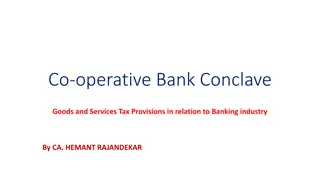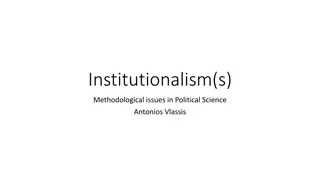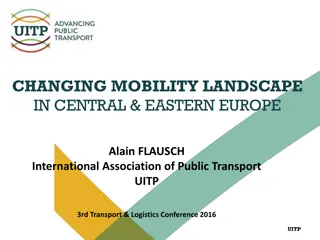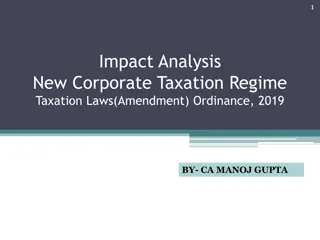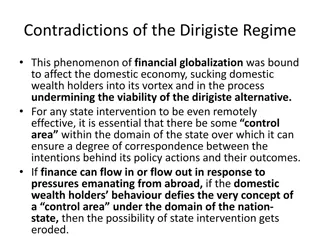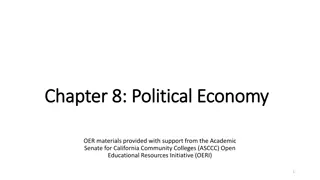The Political Economy of Regime Change in Central-Eastern Europe
The content discusses the concepts of socialism and capitalism, exploring various models and transitions from socialism to capitalism. It focuses on regime changes in Central and Eastern Europe, with case studies on Poland and Hungary. The text covers different varieties of socialism and their economic and political implications, providing insights into the evolution of economic systems pre-regime change.
Download Presentation

Please find below an Image/Link to download the presentation.
The content on the website is provided AS IS for your information and personal use only. It may not be sold, licensed, or shared on other websites without obtaining consent from the author. Download presentation by click this link. If you encounter any issues during the download, it is possible that the publisher has removed the file from their server.
E N D
Presentation Transcript
The Political Economy of Regime Change in Central-Eastern Europe B lint MADLOVICS Foundations of Political Economy BCE, 28 November 2019
Outline 1. What is Socialism? What is Capitalism? three basic models of socialism; general ideal of capitalism 2. Transition from Socialism to Capitalism liberalization, stabilization, privatization 3. Regime Change in Central and Eastern Europe: Poland and Hungary political antecedents; case studies 4. Recommended literature
What is socialism? What is capitalism? economic side: different solutions to the coordination problem political economy: different regimes, sets of institutions varieties of capitalism, varieties of socialism (pre- regime change)
Varieties of Socialism: 1. Classical (Stalinist) Model 1. exclusive state ownership of most, if not all non-agricultural means of production economic management through administrative command (central planning with physical targets) economy and society incorporated into a totalitarian state (one- party dictatorship, autarky) limited role of money BUT using prices, taxes and budgets at various levels of state as mechanisms of control over the economy and society economic growth pursued for political and ideological goals (competition with the West) instead of improving living standards shortage economy 2. 3. 4. 5. 6.
Varieties of Socialism: 2. Yugoslav Reform Model (from 1950s) 1. instead of direct state-ownership, nominal ownership by employee s cooperatives 2. self-management in selecting and appointing managers of individual firms 3. two-tier banking system (banks were regional monopolies, under the direct influence of client enterprises) 4. opening toward Western economic influence
Varieties of Socialism: 3. Hungarian Reform Model (from 1968) 1. dominant (not exclusive) state ownership; private ownership was tolerated, only on a small scale in the beginning (service sector) but private property was acknowledged and institutionally protected collective farming BUT farmers were allowed to have relatively sizable household plot (eliminated the shortage of food!) indicative central planning; more autonomy in simple reproduction (in the lack of physical targets) consumption: no longer rationing or dictatorship over needs, money ( semi-hard currency status) foreign borrowing and debt instead of shortage (1982: Hungary joins IMF) freedom of movement, more bargaining power of the worker, more flexibility in wages more open economy: 50% East, 50% West; Comecon 2. 3. 4. 5. 6. 7.
Capitalism and System Change the ideal: dominant private ownership, competitive entrepreneurship with hard budget constraints, buyers market instead of sellers market (Kornai) System change: from socialism to capitalism, from one-party dictatorship and state ownership to multi-party democracy and private ownership; restoring the relative autonomy for institutions in all spheres of societal existence (Bokros) HOW? in theory (debates): shock therapy vs. gradualism, sequencing of reforms (SLIP) etc. in practice: political imperatives, values and ideologies, and popular acceptance
Transition from Socialism to Capitalism: 1. Liberalization of entry and exit of new ventures (freedom of entrepreneurial activity); of prices, which reflect information about demand and provide the basis of market competition (including: of money, internal and temporal prices interest rates and external and spatial prices exchange rates, so relative scarcity in the world market becomes the ultimate reference point); employment and wages (this can cause inflation) restoring consumer autonomy, a critical mass of private businesses responding to the fast changing structure of demand
Transition from Socialism to Capitalism: 1. Liberalization making visible the structure and degree of economic distortions caused by the constant and massive misallocation of resources in the communist system transitional crisis: (hyper)inflation, output decline, mass unemployment, rampant poverty. What is to be done? nothing (politically unfeasible) reverse liberalization (Balkan) macroeconomic stabilization
Transition from Socialism to Capitalism: 2. Macroeconomic stabilization monetary policy: independent central bank problem: (hyper)inflation, price stability should be reached no monetary financing of deficit new currency had to be established in 14 CIS countries! fiscal policy: fiscal prudence problem: financial disequilibrium, double-digit and persistent fiscal deficit, current account (CA) deficit made difficult by the collapse of tax revenues and the new safety net (unemployment benefits and social transfers) but mitigated by cutting state-subsidies (hardening budget constraint) and restrictive income policy (e.g. Poland) banking prudency: lend only to those who can repay
Transition from Socialism to Capitalism: 3. Regime-changing privatization re-establishment of private ownership (after it was abolished in communist nationalization / collectivization) making capitalism without capitalists (Szel nyi) not just selling SOEs, but organic development of new private firms It is supposed to bring about fundamental change in enterprise behavior and the incentive structure for managers at the helm of private and state-owned firms alike. Privatization of the national economy means, therefore, that the profit motive and the creation of more and more market value for owners, as principal stakeholders, is now a concept and consideration of paramount importance. [ ] As a result, after privatization enterprises are supposed and expected to act, first and foremost, in the interest of their private owners [ ]. From that moment onwards individual economic organizations no longer existed as mere administrative units of a single monstrous state entity; they were reconstituted as enterprises. (Bokros)
Technocratic Dimensions: Openness of the Privatization Market Openness of the market Corruptibility potential Barriers to entry Open Low Share issue privatization Minimal capital requirements High capital requirements Public auction Public tender Multi-criterion decision Restricted auction Need for invitation Need for appointment by the ruling elite Direct selling Closed High
Technocratic Dimensions: Object of Privatization What is privatized? Special post-transfer relation of state to business Post-transfer economic form Contracting out Activity Customer Artificial monopoly Franchising (licensing) Artificial monopoly (oligopoly) Enterprise Regulator Direct privatization (partial) Competitive firm (with state interference in the management) Enterprise (+ assets) Co-partner Direct privatization (total) Enterprise + assets - Competitive firm
Unfeasibility of technocratic change different intentions from technocracy, but even technocrats faced hardly surmountable challenges: 1. there was no financially sound internal demand, for under the conditions of state monopoly and the command economy no one could have accumulated assets close to what would have been needed; 2. when an administrative market and command economy are collapsing, it is impossible to determine the exact value of a former state corporation in a market environment that has not even been established. After all, neither the price of the products nor the costs of production nor for that matter supply and demand had been shaped by market forces. (Of course, it could be suspected that the raw materials industry, which had been selling at depressed rates compared to international rates, would bring significant profits to those who managed to grab it.)
Non-Technocratic Motives of Privatization: Justice Making Temporal dimension of justice-making Legitimation basis of privatized ownership Scope of privatized property Form of justice-making Pre-nationalization / pre-collectivization period Reprivatization Former owners Former property Pre-nationalization / pre-collectivization period Compensation Former owners Optional property Insider privatization (management-employee buyout, MEBO) Pre-regime change period Operators of the assets Operated property Free distribution among citizens (voucher) Pre-regime change period Citizens Optional property
Non-Technocratic Motives of Privatization: Transformation of the Power of the Nomenklatura Way of capture by the nomenklatura Graduality of capture by the nomenklatura Beneficiaries Outsiders (+ nomenklatura) in high number Making use of superior social and knowledge capital Bottom-up power transformation Single stage Nomenklatura (+ outsiders) in high number Facilitating the concentration during secondary privatization Horizontal power transformation Multistage Nomenklatura in low number Top-down power transformation Direct selling ( the state privatizes itself ) Single stage
Destinations of the old economic nomenklatura Class position of 1988 economic nomenklatura in 1993 Elite Russia (N = 60) Poland (N = 263) Hungary (N = 82) 81.1 56.6 29.2 Non-elite with subordinates 13.2 12.6 18.3 Non-elite without subordinates Retired 1.7 7.2 4.9 3.3 23.6 47.6 Source: Szel nyi and Szel nyi (1995, 627)
Regime Change in Central and Eastern Europe Why not the Chinese path? the Hungarian communist leadership wanted this politically unfeasible: the people saw communism as foreign oppression, against which they can now gain freedom (GDR, Czechoslovakia, Poland, Baltic States) Western linkage and leverage (high number of economic, intergovernmental, technocratic, social, information and civil-society ties + vulnerability to Western democratization pressure) (Levitsky and Way)
The Case of Poland no reform model, but relatively weak socialism 1980s: official statistics show 2-4% GDP growth, but there are significant shortages and dollarization fall of socialism: hyperinflation shock therapy: liberalization, macrostabilization and institutional transformation policies at the same time Balcerowicz: extraordinary politics mass privatization could not happen (they did not want large foreign ownership at first), the share of private owners grew because of new enterprises most reform policies toward SOEs took place only after 1993 by the new government
The Case of Hungary Hungarian modified model (New Economic Mechanism, 1968) growing from relatively cheap loans (1984-1987) four steps of transition (L szl Csaba): 1987: two-tier banking system and competition authority -- starting changes that deliberately stepped beyond any socialism 1990: Antall government, liberalization and crisis management; privatization, bottom-up power transformation 1994-1998: Horn government, privatization and macroeconomic stabilization (Bokros-Sur nyi package) a one-off 9 percent devaluation of the forint and the introduction of a preannounced crawling peg with gradually lower rates; an 8 percent surcharge on all imports except primary energy and investment goods, with a preannounced firm timetable for its phasing out; a negotiated double-digit reduction in real wages as well as lower inflation to restore the international competitiveness of Hungarian labor; some structural reforms 1998-2000: finishing stabilization and privatization, protection of private property and steps toward joining Western alliance (NATO, EU)
Recommended literature slund, Anders, and Simeon Djankov, eds. 2014. The Great Rebirth: Lessons from the Victory of Capitalism over Communism. Washington, DC: Peterson Institute for International Economics. Bokros, Lajos. 2013. Accidental Occidental: Economics and Culture of Transition in Mitteleuropa, the Baltic and the Balkan Area. Budapest New York: CEU Press. Csan di, M ria. 2009. The Chinese Style Reforms and the Hungarian Goulash Communism. Discussion Paper; Centre for Economic and Regional Studies, Hungarian Academy of Sciences. http://econ.core.hu/file/download/mtdp/MTDP0903.pdf. Kornai, J nos. 1992. The Socialist System: The Political Economy of Communism. Oxford: Clarendon Press. So s, K roly Attila. 2011. Politics and Policies in Post-Communist Transition: Primary and Secondary Privatisation in Central Europe and the Former Soviet Union. NED-New edition, 1. Budapest New York: CEU Press.









